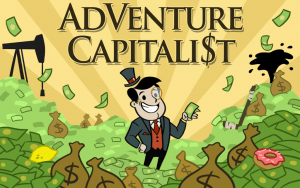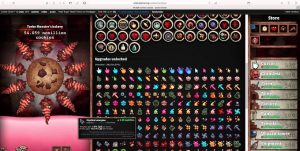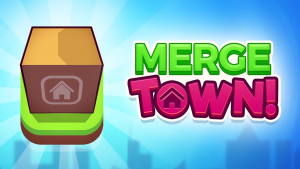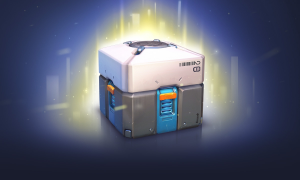Top 7 Idle Game Mechanics
The idle game genre has been heating up quickly on mobile. What was once a small indie niche has been expanding rapidly over the last years. So how do you, as a developer, take advantage of this trend? How can you create the next idle game idea that will dominate the market?
This is a follow up to our Top 10 Game Mechanics for Hyper Casual Games article that you might also enjoy
Idle game mechanics are nothing new. Anthony Pecorella of Kongregate diving in deep into the trend back in GDC 2015, but moving into 2019 we’re seeing some advancements in the trend.
I remember playing Cookie Clicker, Adventure Capitalist, Tap Titans, and the mountains of clones of the simple idle game landed in 2014, but then the trend died out. Yet something changed. Starting in 2016, we’ve actually seen a big resurgence of the mobile idle game genre:
Aggregate downloads and revenue growth for mobile idle game genre from Q3 2016 to Q2 2018
Source: Sensor Tower Estimates
Looking at idle games from 2014 to 2018, we can see a growing trend for both downloads and revenue in this genre. This is not the case for most of the mature genres on mobile. Puzzle, Simulation, Casino, and Strategy all have stabilized or declined in downloads, and seen slow growth in revenue. These genres are locked up, but Idle remains a hotbed of innovation on the mobile market.
In the last years we’ve seen a lot of completely new styles of idle game mechanics hit the market and see success: Merge Town by Gram Games challenged the assumption that idle games were only for spreadsheet-savvy mathematicians, Trailer Park Boys by East Side Games shows a path where Idle games can actually host a compelling narrative, and Idle Miner by Kolibri (previously Fluffy Fairy) shows that idle games can create compelling traditional simulation-style game loops.
For this post, I’d like to showcase the variety of paths to success that an idle game can have. While this may be focusing solely on the past, the hope is that this can inspire you to create better idle game ideas for the future.
What is Idle? how does it work?
If you’ve been living under a rock and don’t understand what idle is, we’ve covered it a number of times: (we’re fans here at MFTP)
Idle games have risen on mobile because it is a genre that is perfect for modern mobile free-to-play design. The mechanics of idle games create perfect mobile sessions and drive strong long-term retention.
Idle games, sometimes called Clicker or Incremental games, are games which are all about management of income. Similar to simulation games, their main differentiator is the focus on revenue growth decisions. For some examples: Idle Games on Kongregate / Reddit’s Guide to Idle Games
The key to the genre: no matter what you choose, you will make progress. But optimizing your decision about what upgrades to purchase next is the core of the strategy and what drives long-term interest in the genre. Because the core of the game is focused on long-term purchasing decisions, retention is built in. Because progress is always felt, it always feels rewarding to come back.
Let’s now dive into the variety of mechanics within the idle genre.
#1 Linear/Clicker Idle
The core of these games are usually insanely simple: tap as fast as you can to generate income. This starts off as fun, but gets pretty tiring and uninteresting quickly. So it quickly shifts into deciding over which upgrades to spend that cash on:
- Do you want to generate more money while you’re away?
- Do you want to generate more income from your own taps?
- Do you want to save up for the big purchase that will increase your income tenfold?
- Or continue to purchase cheap upgrades for small income gains?
This decision-making structure has stuck with idle, but the core gameplay of tapping as fast as you can has not.
Over time, developers tried changes to the core gameplay to make it last a bit longer: Make it Rain! and Farm Away used swipe controls instead of tap to make it more mobile friendly. However, the core mechanic always quickly became a bore, and the appeal of just swiping or tapping as fast as you can to progress is only appealing to some.
Also, due to the nature of the game, prestige mechanics became a necessity. Pushing the player to reset their progress back to the beginning in order to make the growth more manageable and ensure the player still felt growth in the slower endgame. This was never all that appealing to players — so developers had to find clever ways to sidestep the issue and incentivize the full reset.
It’s important to note that this style of game has gone out of fashion. Besides Partymasters (pictured), there haven’t been many successful new titles that only use clicker gameplay or similar. The resurgence of the genre has actually been on taking the progression mechanics learned in this genre and applying it to whole new mechanics, whole new audiences.
#2 Arcade Idle
So what do you do when clicking style gameplay is uninteresting? Take the same progression system mechanics you know work well, and graft it onto more compelling core gameplay. Enter Voodoo, who mastered this approach throughout 2017 and early 2018.
Instead of asking the player to tap to earn their coins, Voodoo asked them to play simple arcade games that have mass appeal. Games like “Idle Invaders” used classic shoot-em-up gameplay (ex. Space Invaders, 1942) to earn their income manually. Shoot down incoming invaders as fast as you can to earn your manual income, and then purchase and upgrade computer-controlled allied fighters to fight alongside you. This made for a compelling formula, that was easily replicated across multiple genres. “Idle Sweeper” took Pac-Man, “Idle Flipper” took flipping style gameplay.
Any simple arcade gameplay which had an opportunity for scaling health/damage and computer-controlled assists could create a compelling new idle game.
Planet Bomber was the first to expand on this formula, adding more depth to the game by adding more types of upgrades. Before, games would offer linear upgrades to damage dealt, or income generated. Planet Bomber now offers upgrades across a number of parallel vectors, all with a variety of importance to the core gameplay. This creates a far more compelling long term strategy, and is what future idle games will need to focus on. How do you find core gameplay that can offer a variety of upgrades that are equally visible and impactful to progress?
#3 Merge Idle
The merge mechanic was first pioneered by games like Triple Town, but turned commercially successful by Gram with Merge Dragons and Merge Town.
Merge style games take out the tiring clicker gameplay and swap it for merging items: drag and drop duplicate items on top of each other to increase their level. What’s a simple premise turns into an addicting experience, because the game always feels like there is something to do. Sessions are impressively long because it’s just so compelling to constantly build up your houses towards the next goal. The next goal is so clear (I want to upgrade my best house), and the path is clear (merge until I get a duplicate) — yet as soon as I complete a goal, I’m compelled to start the next path.
What Merge Town did more than just increase the session length was bring in an entirely different audience. No longer are idle games just about increasing numbers, but giving clear visual progress. This type of gameplay is for a much broader audience than most idle games, yet kept all the engagement mechanics intact.
#4 Idle Simulation
Simulation has been on the decline on mobile for years, with Sim City Build It and Fallout Shelter (arguably) being the last big games in the space. Yet on Idle, in the last year we’ve seen a new face of simulation games: Idle Simulation. Wheras Sim City Build It, Farmville, Hay Day may appeal to a older, broader demographic, Kolibri’s “Idle Miner Tycoon” and “Idle Factory Tycoon” have shown a compelling business case for using classic simulation game loops.
Unlike the previous idle game mechanics, idle simulation games don’t innovate in the core gameplay. In fact, with Idle Miner and Idle Factory — they remove a core mechanic altogether. Tapping fast no longer helps you — the game stays compelling by asking you only to be managing your upgrades, and managing what boosters to start. This used to be an issue for idle games — since idle games typically had to start slow and progress quickly in order to give you a sense of progress, tapping gameplay was an easy out for designers to give a player something to do between upgrades. With simulation games, the upgrades are fast, but also far more strategic. As such, it doesn’t need tapping style gameplay as a crutch.
These games rely on a traditional simulation game loop, similar to compulsion loops you felt in games like Sim City (the original) and Roller Coaster Tycoon. Purchasing one upgrade will strain another system. In Idle Miner, purchasing an upgrade for a mine will mean that mine generates more income per second. This puts a strain on your elevator — the elevator then needs to be upgraded in order to hold on to more resources. Upgrading that elevator will put a strain on your surface level extraction… This goes round and round straining each system giving you new goals with each step and avoiding upgrades feeling stale.
Idle Miner and Idle Factory aren’t the only games that have attempted this and succeeded. I’d recommend playing Crafting Idle Clicker, Reactor Idle, and Factory Idle on Kongregate. This genre has seen the biggest surge in downloads, and there is plenty of room for innovation to come. This is the category to watch for new developers.
#5 Idle Management
One mechanic that hasn’t been done often on mobile, but more often on Kongregate is more “Management” style sims. Check out a game called “Groundhog Life”: this is a life management simulator, with obvious idle characteristics.
The core gameplay is replaced with choosing which system to boost. In Groundhog Life, you can choose how you want to spend your 24 hours each day: spend 8 hours or 2 hours sleeping? Spend more time at work, or studying? While your character is always making progress, whether they are progressing in learning a new skill, earning money, or being happy is down to the decisions you make. Each time you die, you pass on your traits to your next life — giving you a boost depending on your choices in the previous life. While there haven’t been many mobile idle games that have used this mechanic, this is by far the most addictive idle game that I’ve ever played.
#6 Story-driven Idle
Going in a different direction, there’s also innovation happening in how idle games have made prestige (resetting your progress) less punishing and more relevant. Trailer Park Boys: Greasy Money by East Side games is a masterclass in this. Many developers have attempted to graft licensed IP onto idle games, but none fit so well as Trailer Park Boys — in the last episode of every TV season, they end up in jail losing everything. East Side baked this into the game design: at the end of each season of generating a ton of cash from idle systems, the boys are caught by the cops and you lose all your money.
This creates a strong narrative arc in the game that makes sense in the idle game loop. Each prestige (which happens more often), the player gets a drip of story. This creates a more interesting long-term goal for the player besides just increasing their numbers.
The game has been a breakout success for East Side Games, and it’s why they’ve been slowly bringing on more licensed IP to work with. Their current game, “The Gang Goes Mobile” based on It’s Always Sunny in Philadelphia is currently in soft launch.
#7 Idle RPG
Lastly, is most likely the biggest in-app purchase revenue generating idle category: RPG.
Clicker Heroes and Tap Titans were arguably the first games in the genre — showing that you can add battle mechanics with an idle progression, but both games actually fit more into category #1 based on their real mechanics. RPG can offer more than just a facade for progress.
Non-stop Knight was the first to break into this space, by adding automatic RPG gameplay as the core, while asking the player to choose when to use their boosters. Instead of linear upgrades, the character then started collecting loot from random drops (thank you Diablo), collecting pets and unlocking new boosts. Non-stop Knight was revolutionary in its time, but in retrospect leaned too heavily on idle progression to make a compelling long-term engagement loop.
The king of Idle RPG is without a doubt Idle Heroes. Instead of leaving too heavily on Idle Progression, they took many of the progression systems from Heroes’ Charge and Galaxy of Heroes. More focus is on a gacha-infused progression system: collect a team of heroes, outfit them with the best possible gear, and compete in limited time events for the currencies you desperately need.
This level of complexity is likely the next step for Idle RPG games. Keeping the compelling simple core gameplay, but creating more strategy in how you create and manage a team of heroes, and building upon an economy which events are necessary to be competitive.
In Summary
As you can see, idle game mechanics support a wide variety of game designs. Don’t just assume the tried-and-tested clicker gameplay is the only option when coming up with idle game ideas.
Idle, unlike most genres on mobile, has a lot of room for innovation. It’s created compelling business cases for many successful gaming companies on mobile, and as a genre has plenty of room for newcomers to enter into. As a designer in this space, I would take a look at what has been done and predict what will come into the future:
- Don’t stick with traditional core gameplay: find new core gameplays that will let you reach new audiences like Merge Town and Idle Invaders
- Add more strategy to the progression: create compelling game loops by using upgrade stats that actually lean on each other. Buying an upgrade in one area will drive you to upgrade in another.
- The market is maturing quickly: don’t underestimate the value of licensed IP or building out a events framework for your live operations.
If you keep this mind, my hope is that the idle market will continue to innovate for years to come!













